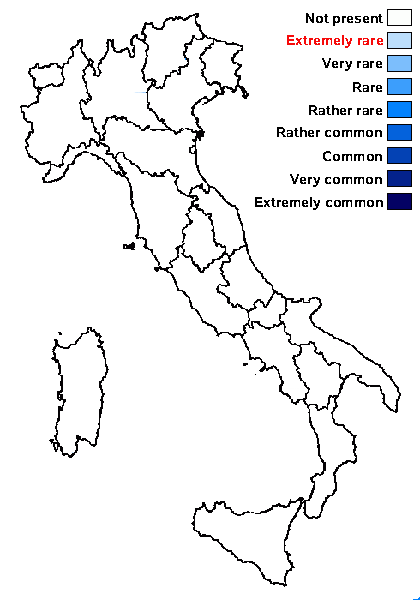Verrucula lactearia Nav.-Ros. & Cl. Roux
in Navarro-Rosinés & al., Bull. Soc. linn. Provence, 58: 160, 2007
Synonyms:
Distribution:
Description: Thallus crustose, areolate, 2-4 mm wide, growing on Xanthocarpia lactea. Areoles clustered in small groups, polygonal or more rarely rounded, flat to slightly convex, (0.1-)0.2-0.6(-0.7) mm wide, 100-250 μm thick, pale brownish grey, epruinose or faintly grey-pruinose, the margins and lower surface dark grey to black. Cortex 7-15 µm thick, paraplectenchymatous, of 1-2(-3) layers of cells with a brownish pigment, partially covered with an epinecral layer; medulla (40-)60-200 μm thick, with abundant crystals in lower part, I-. Perithecia 1-3(-5) per areole, entirely immersed or slightly projecting only with the black ostiolar region. Involucrellum absent; exciple globose, 13-30 μm across, paraplectenchymatous, 13-30 µm thick at base, colourless except around the ostiole; hamathecium of periphyses along the ostiolar channel, pseudoparaphyses in upper part of the perithecium, and paraphyses disappearing early; pseudoparaphyses 17-30 x 2.5-4.5 μm; hymenial gel hemiamyloid. Asci 8-spored, clavate, bitunicate, with a thin tholus reacting I-, Verrucaria-type. Ascospores 1-celled, hyaline, ellipsoid, (9-)10.5-13.5(-14.5) x (5-)5.5-7(-7.5) µm. Pycnidia black, immersed, Dermatocarpon-type, the wall colourless except at the brown apex. Conidia simple, bacilliform, (2-5-)3-5-5 x c. 1 μm. Photobiont chlorococcoid. Spot tests: K-, C-, KC-, P-, UV-. Chemistry: without lichen substances.Note: a rare lichenicolous lichen growing on Xanthocarpia lactea on calcareous pebbles; widespread in SW Europe, including the Western Alps (France); to be looked for in Italy.
Growth form: Crustose
Substrata: rocks
Photobiont: green algae other than Trentepohlia
Reproductive strategy: mainly sexual
paras Xanthocarpia lactea

Predictive model
Growth form: Crustose
Substrata: rocks
Photobiont: green algae other than Trentepohlia
Reproductive strategy: mainly sexual
paras Xanthocarpia lactea

Predictive model
 INDEX FUNGORUM
INDEX FUNGORUM
 GBIF
GBIF

